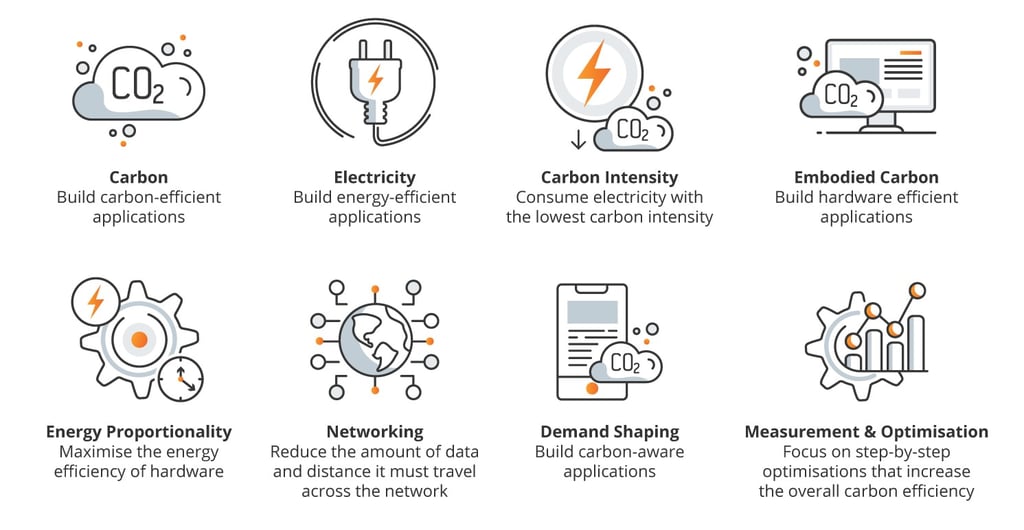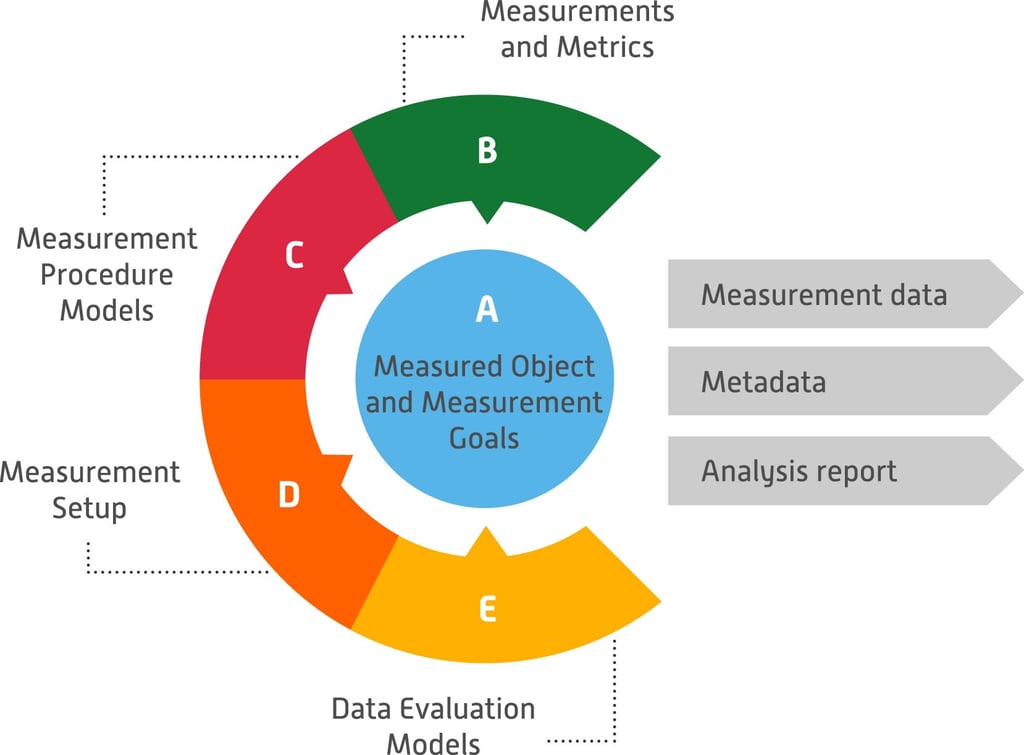Developing a Green Software Measurement Model for Enhanced Resource and Energy Efficiency
GREEN SOFTWARE PRACTICES


Introduction
For years, when we talked about the environmental impact of technology, our focus was primarily on hardware—the energy consumed by servers, data centers, and devices. And rightfully so; the Information and Communications Technology (ICT) sector is a significant contributor to global greenhouse gas emissions, currently accounting for approximately 2–3%, or 1.0–1.7 gigatons of CO2 equivalent (GtCO2e), of total emissions (Guldner et al., 2025). Estimates even suggest that by 2025, global ICT energy use could exceed 20% of total energy and emit up to 5.5% of the world's carbon emissions, especially with the rise of energy-intensive technologies like AI and machine learning.
However, there's a critical nuance: while hardware consumes energy, it's the software that dictates and triggers its usage. This means that the code we write, the applications we develop, and the systems we deploy have an unquestionable influence on energy consumption.
Despite this, developers often lack experience in understanding software-induced energy consumption, and the industry has struggled with a lack of standardized measurement setups, methods, and tools. This makes it difficult to compare results, replicate analyses, or truly understand where our software is contributing to environmental impact. What's been missing is a comprehensive reference model to guide these essential measurements.
Introducing the Green Software Measurement Model (GSMM): A Unified Approach
This is precisely where the Green Software Measurement Model (GSMM) steps in. Developed through the collaborative efforts of over 10 research groups from four countries, the GSMM is designed to bring together core ideas, measurement setups, and methods for assessing the environmental impact of software (Guldner et al., 2025).
The primary aim of the GSMM is to supply a framework that contains essential elements for measuring software and to present existing measurement methods. This initiative is crucial for integrating the measurement and improvement of software resource and energy efficiency into the daily work of all involved stakeholders, including developers, administrators, and users. It's a vital step towards establishing a reference model for measurement and analysis methods to assess the resource and energy efficiency of software (Guldner et al., 2025).
The GSMM helps stakeholders throughout a software product's lifecycle to navigate the growing array of available measurement methods, enabling them to develop, plan, conduct, and analyze measurements effectively.


This figure shows the 8 major components of sustainable software engineering practices. Reference: https://www.future-processing.com/blog/how-to-build-green-software-development/#pid=1
Deconstructing the GSMM: What Does It Entail
The GSMM is structured around several key components, providing a systematic approach to green software measurement (Guldner et al., 2025):
Measured Object and Measurement Goals (A): This foundational step involves defining what specific software product or part will be measured and for what purpose. Common goals include comparing software over its development process (e.g., between releases or features) or against different implementations or products.
Measurements and Metrics (B): Once goals are set, the relevant metrics are determined. These can range from simple execution duration and network traffic for users to detailed CPU/GPU usage, RAM usage, permanent storage, mean power draw, and even specialized energy efficiency factors for developers.
Measurement Procedure Models (C): This component outlines the steps for conducting measurements, including defining scenarios (like baseline, idle, standard usage, or load scenarios), repetitions, and which tools to use. Scenarios can be black-box (focusing on overall functionality) or white-box (assessing individual code parts).
Measurement Setup (D): This involves identifying the necessary hardware and software environment for the measurement, including the System under Test (SuT), metering devices (external power meters or software-based loggers), and other tools.
Data Evaluation Models (E): This defines the methods for analyzing and evaluating the collected data and preparing the measurement report. This includes calculating metrics, visualizing results, and conducting statistical analyses. Tools like OSCAR or the Green Metrics Tool can automate this.
Generated Data: The output includes raw measurement data, analysis reports, and crucial metadata describing the entire experiment. This metadata is vital for ensuring transparency, reproducibility, and the ability to find measurement errors in the future.


This figure shows the main components of the GSSM model. Reference: https://doi.org/10.1016/j.future.2024.01.033
A Collaborative Journey: Building on Existing Expertise
The GSMM isn't built in a vacuum; it synthesizes knowledge from numerous pioneering measurement methods (Guldner et al., 2025). These include:
SERENA (Software Energy and Resource EfficieNcy Analysis): A method for assessing energy and resource efficiency by measuring the entire physical system using power meters and resource-monitoring tools.
Green Software Measurement Process (GSMP): Details activities and roles for measuring software energy consumption.
SAF Toolkit and Green Lab: Tools and an experimental platform for guiding sustainability decisions and conducting empirical studies on software quality, particularly energy efficiency.
Green Metrics Tool (GMT): An industry tool that isolates applications in containers for precise measurement of power, network, disk, and memory consumption.
Cloud Energy Usage Estimation Model: A machine learning model that estimates energy usage in cloud environments where controlled measurements aren't feasible.
Software Footprint Tool: A low-threshold tool for developers to check energy consumption on their local development computers, primarily based on CPU load.
SDIA Emission Estimation Framework: A mathematical model to estimate software energy consumption focusing on CPU usage measurements.
Container Overhead Measurement Methodology (COMM): Designed to pinpoint efficiency deficiencies within container configurations and environments.
These diverse methods, while unique in their focus and application areas, collectively informed the development of the GSMM, demonstrating its versatility across different software types, hardware, and usage scenarios.
Conclusion
While the GSMM represents a significant leap forward, it's important to acknowledge that the journey isn't over. Current methods within the model primarily address core components of complex software systems and are not yet fully applicable to highly complex architectures or distributed systems. However, the GSMM is adaptable and can be extended to include these challenges in future iterations.
Ultimately, the GSMM aims to enhance software sustainability by simplifying the process for developers and researchers to devise new measurement models or to choose, tailor, and expand upon existing methods. By promoting a shared understanding, clarifying terminology, and providing a structured framework with an open repository for universal contribution, the GSMM empowers the scientific community and software developers to integrate energy and resource measurements into software practice more effectively than ever before.
This collaborative spirit and continuous improvement are key to truly embedding sustainability into the very fabric of software engineering. Let's work together to build a greener digital future!
Reference
Guldner, A., Bender, R., Calero, C., Fernando, G. S., Funke, M., Gröger, J., Hilty, L. M., Hörnschemeyer, J., Hoffmann, G., Junger, D., Kennes, T., Kreten, S., Lago, P., Mai, F., Malavolta, I., Murach, J., Obergöker, K., Schmidt, B., Tarara, A., . . . Naumann, S. (2024b). Development and evaluation of a reference measurement model for assessing the resource and energy efficiency of software products and components—Green Software Measurement Model (GSMM). Future Generation Computer Systems, 155, 402–418. https://doi.org/10.1016/j.future.2024.01.033
Subscribe to our newsletter


